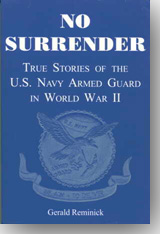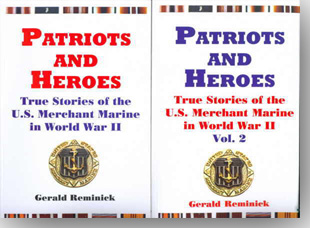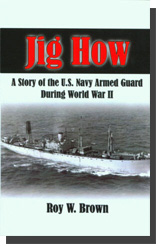In both World Wars, the United States Navy trained an provided gun crews for service aboard US Merchant Ships, known as the: US Navy Armed Guard Service.
No Surrender by Gerald Reminick, from The Glencannon Press.
Patriots and Heroes Volumes 1 and 2, also written by Gerald Reminick.
Jig How by Roy W. Brown. Available through Publish America, PO Box 151, Frederick. MD. 21705.
URL for a list of those killed whilst on service with the US Navy Armed Guard.
Interesting web site with a great deal of information about the Armed Guard Service.
The story of the U.S. Naval Armed Guard Service is not well known. Over the years, a book or two on the subject has found its way into print, but I know of none that has been a best-seller. Even the Armed Guard heroes -- and there were more than a few -- were known for the most part only to their shipmates. So what follows here is not likely to attract great numbers of readers, but it may help an old sailor here and there to explain to his grandchildren what he did in that long-ago war that began, for us, with Japan's attack on Pearl Harbor.
At the outset it might be wise to clarify what the Armed Guard was. The words could call up an image of a sailor in web belt and leggings, a rifle over his shoulder, marching back and forth at the entrance to a Navy base. It is doubtful, however, that any member of the Armed Guard ever carried out any such assignment.
The Armed Guard was made up primarily of men who manned the guns on merchant ships. These ships were mostly tankers and freighters but also included passenger liners fitted out as troop transports. The men who made up their crews -- officers, deck hands, oilers, cooks -- were civilians. There were instances of friction between Navy and merchant sailors, but they were relatively rare. Gunner and merchant sailor faced the same dangers, and both knew the time might come when their survival might well depend on the other.
Not everyone in the Armed Guard dealt with guns. There were signalmen, too, and radiomen, even a few pharmacist's mates. And virtually every Armed Guard crew was commanded by a commissioned officer, in most cases a young ensign or lieutenant (j.g.) recently removed from a college campus. Regardless of rank or rating, these men shared the same hardships. Today they share the memories.
The memories are as varied as the men themselves, who came from every corner of the country and every sort of background. Most were young, not yet in their twenties, and many had grown up far from salt water and had never so much as sniffed salt air. Still, they took to the sea like so many Gloucestermen, and they look back with pride and satisfaction on the months and years they spent at sea -- often actually in the sea after being torpedoed and forced to take to the boats and rafts.
It was the best of times and the worst of times: liberty in exotic ports far from the war, standing alone in the ship's bow in the dark of night, watching the bow wave curl away in a streak of phosphorescent bubbles, or watching in terror after sighting first a periscope and then the unmistakable wake of a torpedo headed your way, or seeing a flight of Messerschmitt 109s banking into a turn that would bring your ship under their guns. Much of it was in-between, neither altogether good nor altogether bad. It was long, wearying hours on watch, maybe in a forward gun tub, or on the flying bridge, maybe in warm, bright sunshine, maybe in frigid, impenetrable gloom. Anyone who went to sea with the Armed Guard will remember dragging himself from his bunk and to his general-quarters station at dawn and again at dusk, day after day, because U-boat skippers favored those times. Never mind that you had just come off watch and had had no sleep for hours.
It isn't likely that many young men enlisted in the Navy with the Armed Guard in mind. It isn't likely that many had ever heard of the Armed Guard. The great majority were probably sworn in and went off to boot camp with a vision of going into action on board a fighting ship -- a destroyer, a cruiser, a carrier -- getting even for that sneaky blow dealt by the Japanese on the morning of Dec. 7, 1941.
After six or eight weeks of boot camp -- what soldiers call basic training -- some recruits were sent directly to the fleet to chip paint and swab decks and learn on the job one of the Navy's specialized skills. Others were sent to a school, sometimes a school of their choice, where they were taught to be cooks and bakers, yeomen, storekeepers, electricians, machinists. Some went, voluntarily or not, to the Armed Guard. They were given a few weeks of training on the weapons they would use, and then transferred to an Armed Guard Center -- a receiving station in Brooklyn or San Francisco or New Orleans -- where they were formed up in gun crews and assigned to ships.
In the early months of the war our merchant fleet was small and old, and there was little in the way of armament available. What there was consisted of leftovers from the 1917 war -- .30- and .50-caliber machine guns and four- and five-inch guns. As the ships were armed, a handful of men were pulled out of the Navy and put aboard these ships to maintain and operate the guns. In those early weeks of the war, a gun crew might number no more than half a dozen seamen under a gunner's mate second or third class. Soon, as new ships began moving down the ways in shipyards on both coasts, they were equipped with up-to-the-minute weapons. Most of the new ships carried a three-inch gun forward and a five-inch gun aft; both were multipurpose, effective against targets in the air and on the surface. Together with these were eight 20-mm. machine guns, usually two forward, four amidships and two aft. And as the new men became available, the gun crews grew, finally averaging about 26 men plus an officer, not including signalmen and radiomen. Of these latter, there might be one or as many as three to a ship.
The convoy system was not widely employed in the vast reaches of the Pacific. Except when taking part in invasions, merchant ships usually proceded independently. But for much of the war virtually every ship that put to sea in the Atlantic joined a convoy. Often these included as many as sixty ships in orderly ranks and files shepherded by U.S., Canadian and Royal Navy escorts. U-boats picked them off almost at will in the early months of the war. In a single year, 1942, the Allies lost 7.5 million tons of shipping to U-boats. In August of that year one convoy lost 26 ships, another 15. As late as March 1943, in an encounter involving the war's greatest concentration of German submarines, 44 U-boats in "wolf packs" attacked convoys SC-122 and HX-229 in the North Atlantic and destroyed 22 Allied ships -- 146 ,000 tons in all.
For all who went to sea in merchant ships, the destinations Murmansk and Archangel topped the list of places no one wanted to go. These ports in the Soviet Union's far north could be reached only at great risk, yet it was through them that the Western Allies supplied the Soviet forces with much of the weaponry they threw against the German invader. Day after day, ships en route to Murmansk were attacked by aircraft, submarines, and surface ships. In June 1942 Convoy PQ17, made up of 33 merchantmen -- 22 of them flying the U.S. flag -- departed Hvalfjord, Iceland, en route to Archangel. Although escorted by destroyers, corvettes, submarines, and minesweepers, only 11 merchantmen and two warships reached their destination. Even those that made it were not home free; there remained the return voyage.
Although losses declined as anti-submarine warfare techniques improved, German U-boats continued to take a toll into the final days of the war. Their last victim, S.S. Black Point, a freighter, was sunk off Point Judith, Rhode Island, on May 5, 1945. Twelve of the Black Point's people were lost, including an Armed Guard boatswain's mate named Lonnie Whitson Lloyd, who had survived an earlier sinking off Ireland in 1943 en route home from Murmansk. By war's end, 144,970 men had served with the Armed Guard.
-- Francis B. Kent



